Thermal Inversion and Particulate Matter Concentration in Wrocław in Winter Season
Abstract
1. Introduction
2. Materials and Methods
3. Results and Discussion
3.1. TI Characteristics
3.1.1. Frequency
3.1.2. Thickness and Strength
3.1.3. Base of the ELI
3.2. Particulate Matter Concentrations
3.3. Cluster Analysis
3.3.1. TI and PM10
3.3.2. TI and PM2.5
4. Conclusions
Author Contributions
Funding
Conflicts of Interest
References
- Stryhal, J.; Huth, R.; Sládek, I. Climatology of low-level temperature inversions at the Prague-Libuš aerological station. Appl. Clim. 2015, 127, 409–420. [Google Scholar] [CrossRef]
- Czarnecka, M.; Nidzgorska-Lencewicz, J.; Rawicki, K. Temporal structure of thermal inversions in Łeba (Poland). Appl. Clim. 2018, 136, 13. [Google Scholar] [CrossRef]
- Palarz, A.; Celiński-Mysław, D.; Ustrnul, Z. Temporal and spatial variability of surface-based inversions over Europe based on ERA-Interim reanalysis. Int. J. Clim. 2018, 38, 158–168. [Google Scholar] [CrossRef]
- Palarz, A.; Celiński-Mysław, D.; Ustrnul, Z. Temporal and spatial variability of elevated inversions over Europe based on ERA-Interim reanalysis. Int. J. Clim. 2020, 40, 1335–1347. [Google Scholar] [CrossRef]
- Devasthale, A.; Willén, U.; Karlsson, K.-G.; Jones, C.G. Quantifying the clear-sky temperature inversion frequency and strength over the Arctic Ocean during summer and winter seasons from AIRS profiles. Atmos. Chem. Phys. Discuss. 2010, 10, 5565–5572. [Google Scholar] [CrossRef]
- Zhang, Y.; Seidel, D.J.; Golaz, J.-C.; Deser, C.; Tomas, R.A. Climatological Characteristics of Arctic and Antarctic Surface-Based Inversions. J. Clim. 2011, 24, 5167–5186. [Google Scholar] [CrossRef]
- Knozová, G. Temperature inversions at Prague-Libuš aerological stadion (1975–2006). In Klimat i Bioklimat Miast; Kłysik, K., Wibig, J., Fortuniak, K., Eds.; Wydawnictwo Uniwersytetu Łódzkiego, Katedra Meteorologii i Klimatologii UŁ: Łódź, Poland, 2008; pp. 65–80. (In Polish) [Google Scholar]
- Brümmer, B.; Schultze, M. Analysis of a 7-year low-level temperature inversion data set measured at the 280 m high Hamburg weather mast. Meteorol. Z. 2015, 24, 481–494. [Google Scholar] [CrossRef]
- Joly, D.; Richard, Y. Frequency, intensity, and duration of thermal inversions in the Jura Mountains of France. Appl. Clim. 2019, 138, 639–655. [Google Scholar] [CrossRef]
- Bourne, S.; Bhatt, U.; Zhang, J.; Thoman, R. Surface-based temperature inversions in Alaska from a climate perspective. Atmos. Res. 2010, 95, 353–366. [Google Scholar] [CrossRef]
- Czarnecka, M.; Nidzgorska-Lencewicz, J. The impact of thermal inversion on the variability of PM10 concentration in winter seasons in Tricity. Environ. Prot. Eng. 2017, 43, 157–172. [Google Scholar] [CrossRef]
- Nidzgorska-Lencewicz, J.; Czarnecka, M.; Rawicki, K. Thermal inversions and sulphure dioxide concentrations in some Polish cities in the winter season. J. Elem. 2016, 21, 1001–1015. [Google Scholar] [CrossRef]
- Malek, E.; Davis, T.; Martin, R.S.; Silva, P.J. Meteorological and environmental aspects of one of the worst national air pollution episodes (January, 2004) in Logan, Cache Valley, Utah, USA. Atmos. Res. 2006, 79, 108–122. [Google Scholar] [CrossRef]
- Nidzgorska-Lencewicz, J.; Czarnecka, M. Winter Weather Conditions vs. air quality in Tricity, Poland. Appl. Clim. 2014, 119, 611–627. [Google Scholar] [CrossRef]
- Largeron, Y.; Staquet, C. Persistent inversion dynamics and wintertime PM10 air pollution in Alpine valleys. Atmos. Environ. 2016, 135, 92–108. [Google Scholar] [CrossRef]
- Hu, Y.; Wang, S.; Ning, G.; Zhang, Y.; Wang, J.; Shang, Z. A quantitative assessment of the air pollution purification effect of a super strong cold-air outbreak in January 2016 in China. Air Qual. Atmos. Health 2018, 11, 907–923. [Google Scholar] [CrossRef]
- Rogula-Kozłowska, W.; Klejnowski, K.; Rogula-Kopiec, P.; Ośródka, L.; Krajny, E.; Błaszczak, B.; Mathews, B. Spatial and seasonal variability of the mass concentration and chemical composition of PM2.5 in Poland. Air Qual. Atmos. Health 2014, 7, 41–58. [Google Scholar] [CrossRef] [PubMed]
- Majewski, G.; Rogula-Kozłowska, W.; Rozbicka, K.; Rogula-Kopiec, P.; Mathews, B.; Brandyk, A. Concentration, Chemical Composition and Origin of PM1: Results from the First Long-term Measurement Campaign in Warsaw (Poland). Aerosol Air Qual. Res. 2018, 18, 636–654. [Google Scholar] [CrossRef]
- Sówka, I.; Chlebowska-Styś, A.; Pachurka, Ł.; Rogula-Kozłowska, W.; Mathews, B.; Styś, C.; Kozłowska, R. Analysis of Particulate Matter Concentration Variability and Origin in Selected Urban Areas in Poland. Sustainability 2019, 11, 5735. [Google Scholar] [CrossRef]
- Medina, S. Apheis: Public health impact of PM10 in 19 European cities. J. Epidemiol. Community Health 2004, 58, 831–836. [Google Scholar] [CrossRef]
- Shi, L.; Zanobetti, A.; Kloog, I.; Coull, B.A.; Koutrakis, P.; Melly, S.J.; Schwartz, J.D. Low-Concentration PM 2.5 and Mortality: Estimating Acute and Chronic Effects in a Population-Based Study. Environ. Health Perspect. 2016, 124, 46–52. [Google Scholar] [CrossRef]
- Widziewicz, K.; Rogula-Kozlowska, W.; Loska, K.; Kociszewska, K.; Majewski, G. Health Risk Impacts of Exposure to Airborne Metals and Benzo(a)Pyrene during Episodes of High PM10 Concentrations in Poland. Biomed. Environ. Sci. 2018, 31, 23–36. [Google Scholar] [PubMed]
- Zwozdziak, A.; Gini, M.I.; Samek, L.; Rogula-Kozlowska, W.; Sowka, I.; Eleftheriadis, K. Implications of the aerosol size distribution modal structure of trace and major elements on human exposure, inhaled dose and relevance to the PM2.5 and PM10 metrics in a European pollution hotspot urban area. J. Aerosol Sci. 2017, 103, 38–52. [Google Scholar] [CrossRef]
- OECD. Environmental Outlook to 2050, the Consequences of Inaction; Organisation for Economic Co-Operation and Development Publishing: Paris, France, 2012. [Google Scholar]
- European Environment Agency. EMEP/EEA Air Pollutant Emission Inventory Guidebook 2019; Technical Guidance to Prepare National Emission Inventories, EEA Report No 13/2019; European Environment Agency: Copenhagen K, Denmark, 2019.
- Available online: http://weather.uwyo.edu/upperair/sounding.html (accessed on 10 December 2020).
- Parczewski, W. Thermal Blocking Layers in Poland; Prace Instytutu Meteorologii i Gospodarki Wodnej: Warszawa, Poland, 1976; p. 8. (In Polish) [Google Scholar]
- Chief Inspectorate Of Environmental Protection. Available online: www.gios.gov.pl (accessed on 10 December 2020).
- Ocena Jakości Powietrza—Bieżące dane Pomiarowe—GIOŚ. Available online: http://powietrze.gios.gov.pl/pjp/current (accessed on 10 December 2020).
- Govender, P.; Sivakumar, V. Application of k-means and hierarchical clustering techniques for analysis of air pollution: A review (1980–2019). Atmos. Pollut. Res. 2020, 11, 40–56. [Google Scholar] [CrossRef]
- Walczewski, J. Some data on occurrence of the all-day inversions in the atmospheric boundary-layer in Cracow and on the factors stimulating this occurrence. Przegląd Geofizyczny 2009, 54, 183–191. (In Polish) [Google Scholar]
- Czarnecka, M.; Nidzgorska-Lencewicz, J.; Rawicki, K. Thermal conditions and air pollution in selected Polish cities during the winter period 2016/2017. Sci. Rev. 2017, 26, 437–446. (In Polish) [Google Scholar] [CrossRef][Green Version]
- Biuletyn Monitoringu Klimatu Polski—Portal Klimat IMGW-PiB. Available online: https://klimat.imgw.pl/pl/biuletyn-monitoring/ (accessed on 10 December 2020).
- Rawicki, K.; Czarnecka, M.; Nidzgorska-Lencewicz, J. Regions of pollution with particulate matter in Poland. In Proceedings of the E3S Web of Conferences, Polanica-Zdrój, Poland, 16–20 April 2018; Volume 28, p. 1025. [Google Scholar]
- Palarz, A.; Celiński-Mysław, D. The effect of temperature inversions on the particulate matter PM10 and sulfur dioxide concentrations in selected basins in the Polish Carpathians. Carpathian J. Earth Environ. Sci. 2017, 12, 629–640. [Google Scholar]
- Xu, T.; Song, Y.; Liu, M.; Cai, X.; Zhang, H.; Guo, J.; Zhu, T. Temperature inversions in severe polluted days derived from radiosonde data in North China from 2011 to 2016. Sci. Total. Environ. 2019, 647, 1011–1020. [Google Scholar] [CrossRef]
- Sabatier, T.; Paci, A.; Canut, G.; Largeron, Y.; Dabas, A.; Donier, J.-M.; Douffet, T. Wintertime Local Wind Dynamics from Scanning Doppler Lidar and Air Quality in the Arve River Valley. Atmosphere 2018, 9, 118. [Google Scholar] [CrossRef]
- Zuśka, Z.; Kopcińska, J.; Dacewicz, E.; Skowera, B.; Wojkowski, J.; Ziernicka-Wojtaszek, A. Application of the Principal Component Analysis (PCA) Method to Assess the Impact of Meteorological Elements on Concentrations of Particulate Matter (PM10): A Case Study of the Mountain Valley (the Sącz Basin, Poland). Sustainability 2019, 11, 6740. [Google Scholar] [CrossRef]
- Żyromski, A.; Biniak-Pieróg, M.; Burszta-Adamiak, E.; Zamiar, Z. Evaluation of Relationship Between Air Pollutant Concentration and Meteorological Elements in Winter Months. J. Water Land Dev. 2014, 22, 25–32. [Google Scholar] [CrossRef]
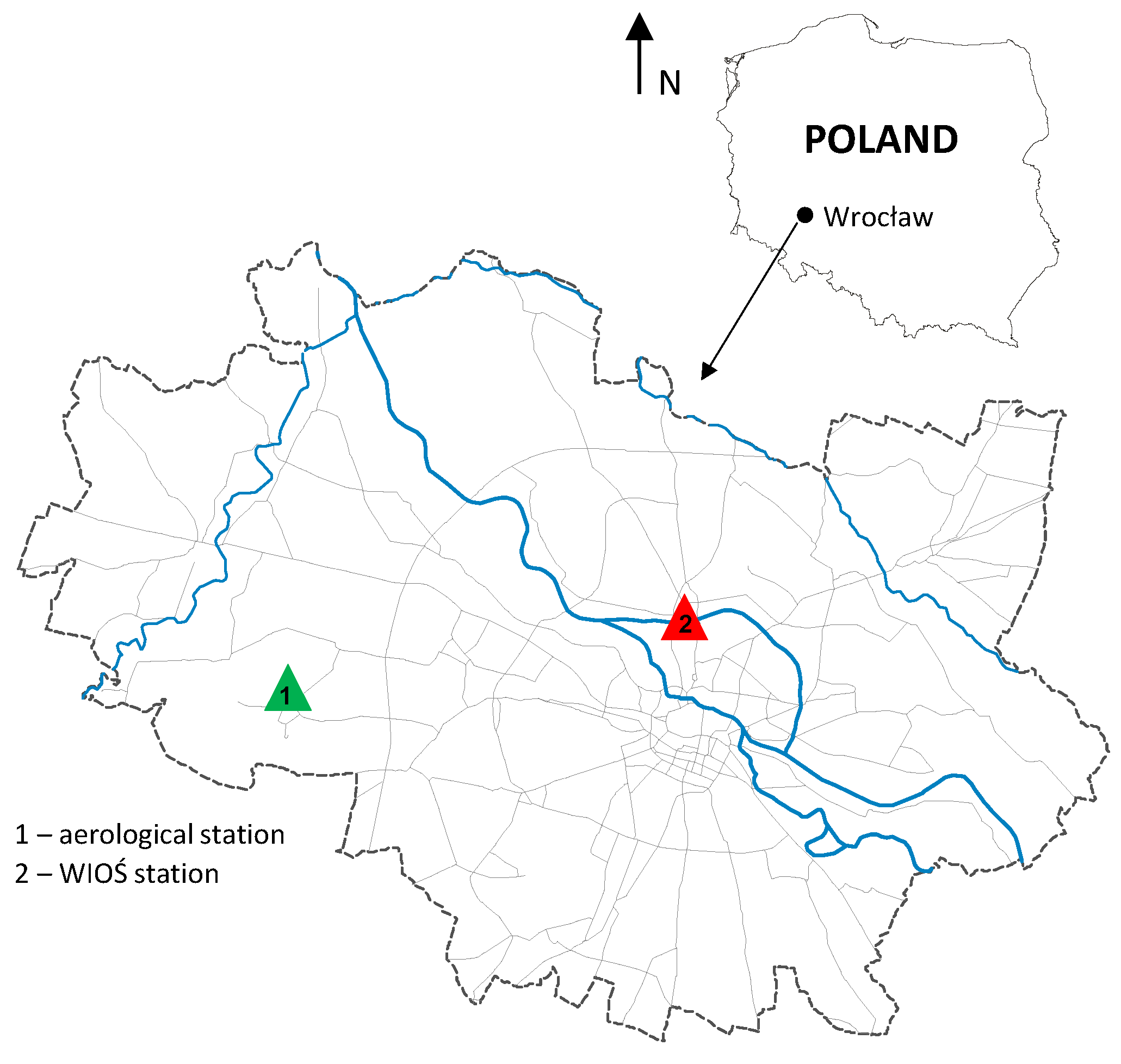
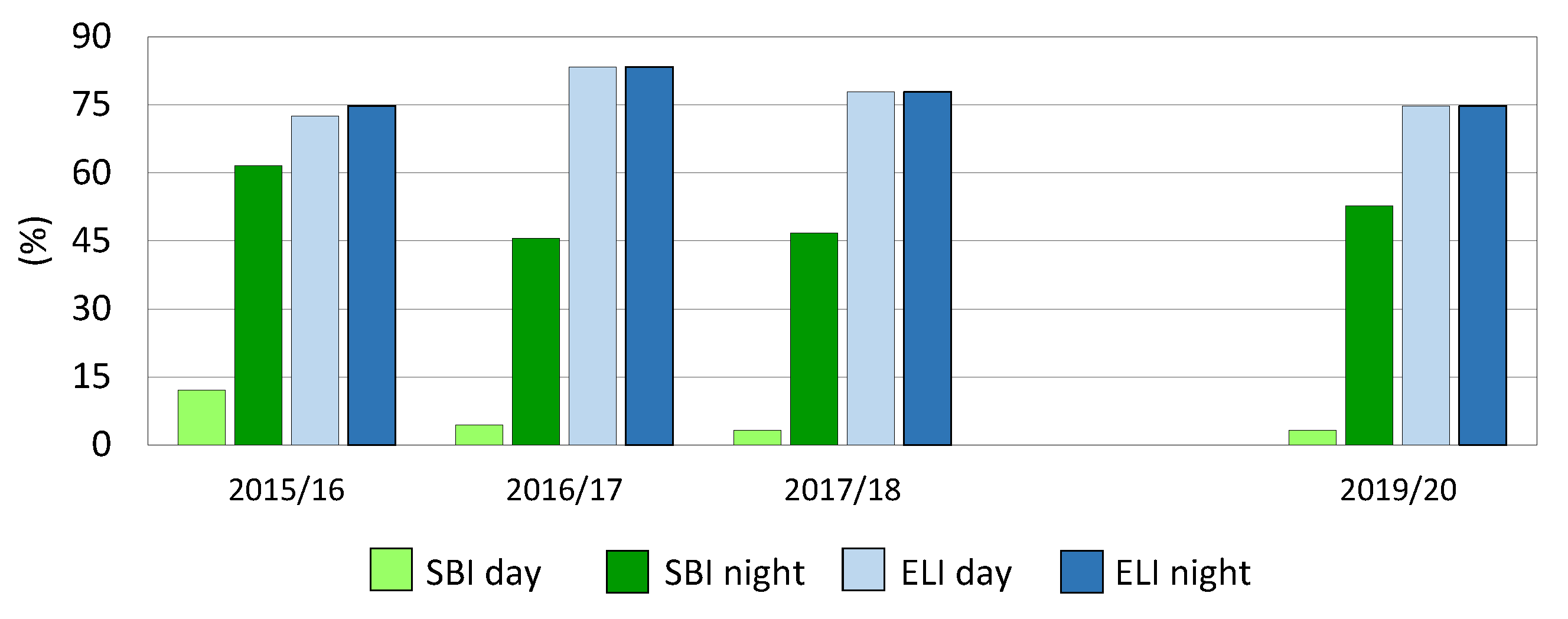

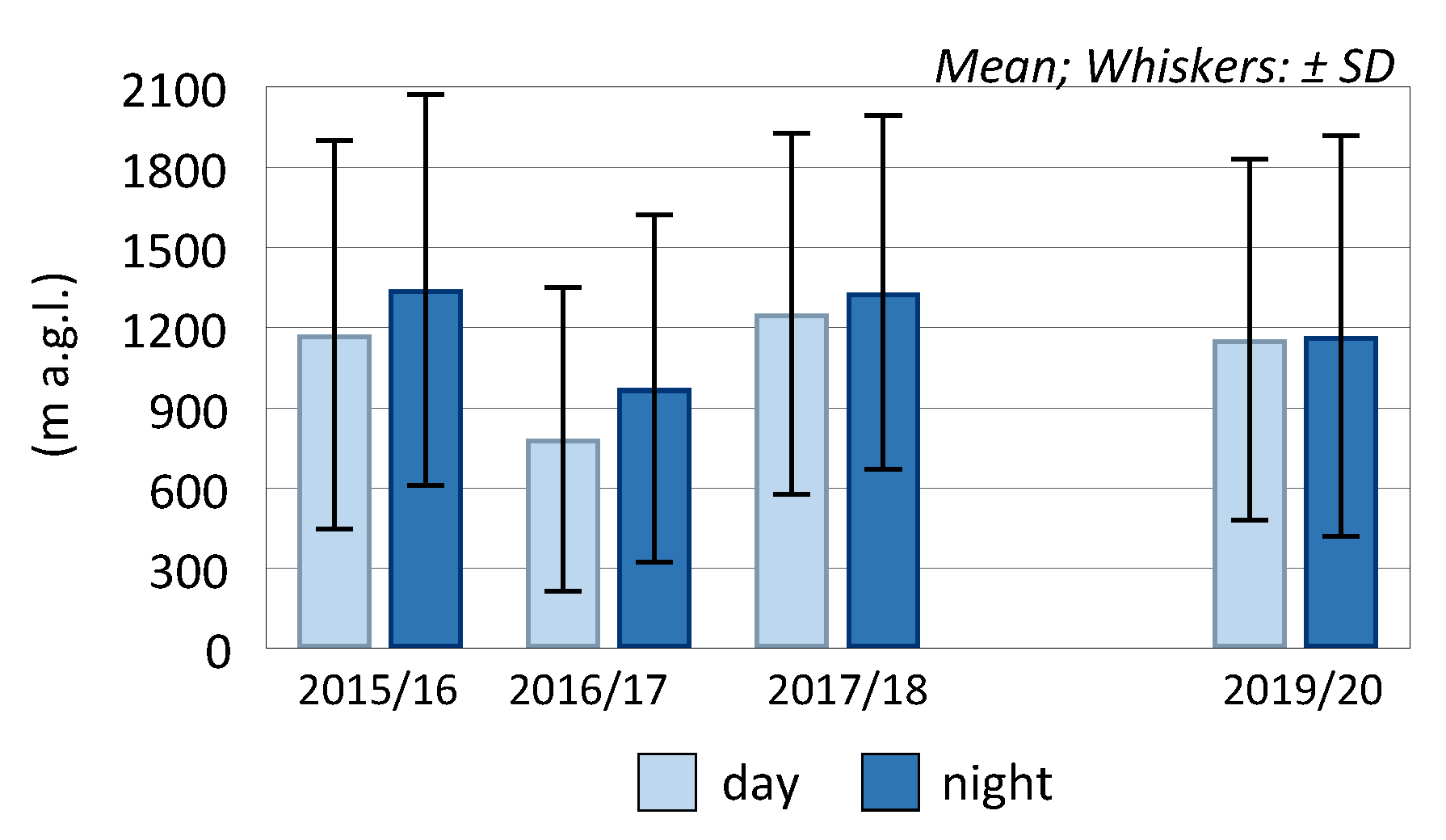

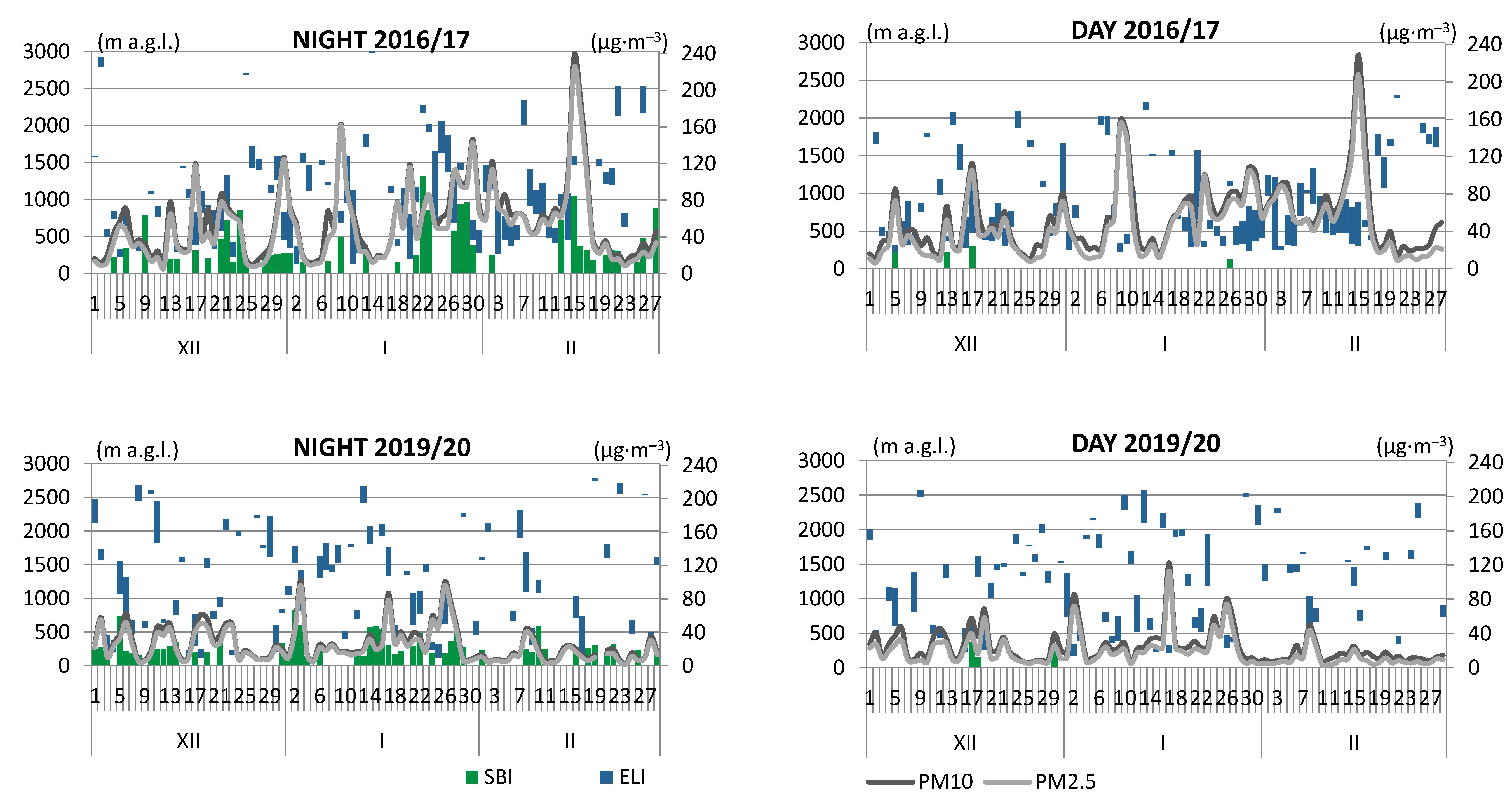

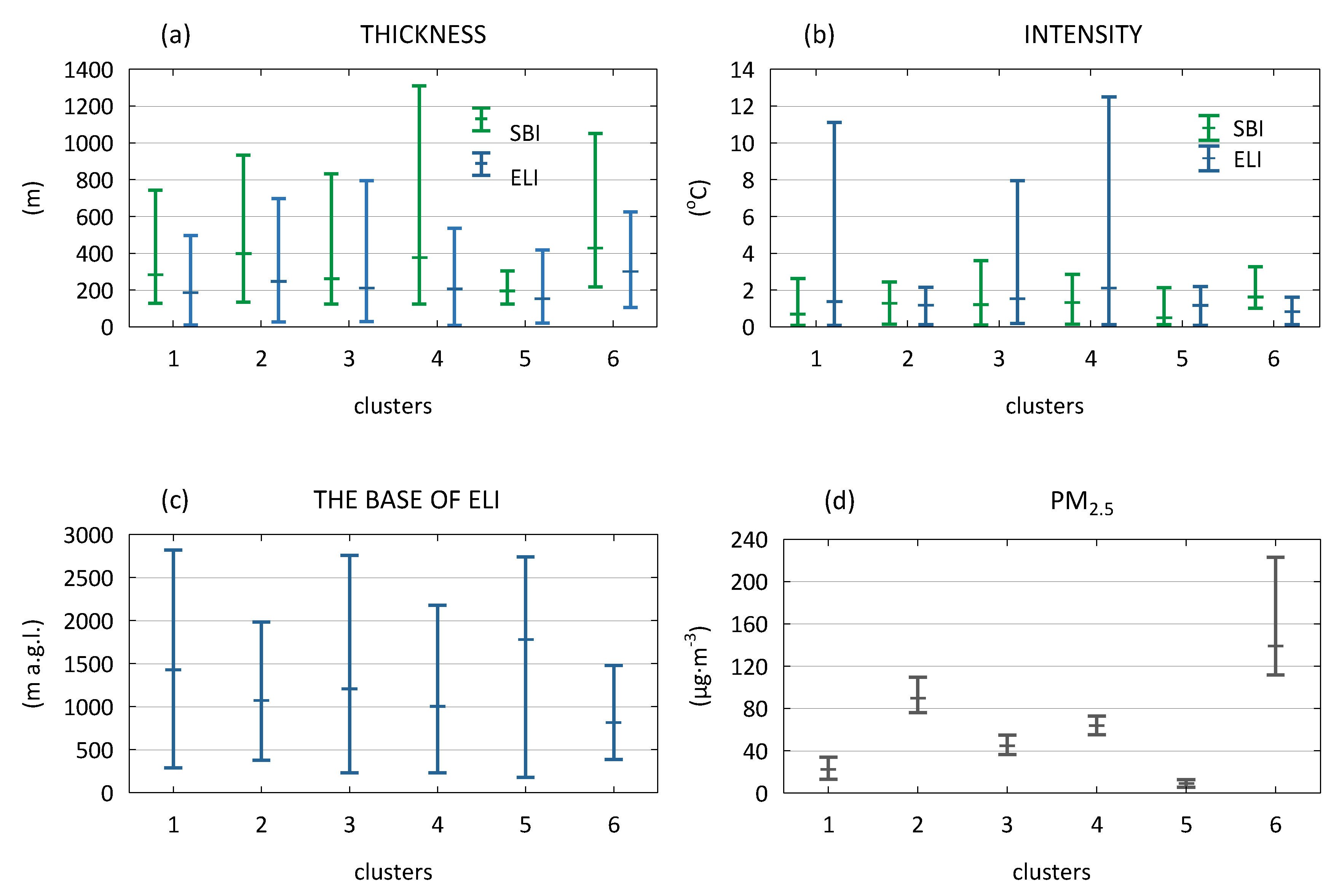
| Clusters | Characteristics of Inversion Layers | PM10 (µg·m−3) | Number of Cases | Percentage (%) | ||||
|---|---|---|---|---|---|---|---|---|
| SBI | ELI | |||||||
| Thickness (m) | Intensity (°C per 100 m) | Base (m a.g.l.) | Thickness (m) | Intensity (°C) | ||||
| 1 a | 280.2 | 1.2 | 769.1 | 255.0 | 1.3 | 35.4 | 26 | 19.0 |
| b | ±51.3 | ±0.4 | ±163.9 | ±65.0 | ±0.4 | ±3.2 | ||
| 2 a | 400.3 | 1.4 | 764.1 | 307.7 | 1.0 | 136.0 | 12 | 8.8 |
| b | ±145.7 | ±0.5 | ±216.3 | ±123.9 | ±0.3 | ±22.4 | ||
| 3 a | 305.8 | 1.1 | 1118.8 | 184.2 | 1.3 | 64.3 | 33 | 24.1 |
| b | ±79.8 | ±0.2 | ±212.3 | ±56.6 | ±0.5 | ±3.0 | ||
| 4 a | 205.9 | 0.5 | 1702.9 | 148.0 | 1.2 | 15.5 | 21 | 15.3 |
| b | ±28.9 | ±0.2 | ±336.8 | ±49.4 | ±0.4 | ±1.9 | ||
| 5 a | 421.1 | 1.4 | 1172.3 | 225.6 | 1.8 | 91.8 | 14 | 10.2 |
| b | ±153.5 | ±0.5 | ±310.8 | ±112.0 | ±1.3 | ±4.3 | ||
| 6 a | 316.7 | 0.6 | 1879.0 | 180.3 | 1.6 | 32.3 | 31 | 22.6 |
| b | ±62.4 | ±0.2 | ±181.4 | ±46.1 | ±0.8 | ±2.7 | ||
| Clusters | Characteristics of Inversion Layers | PM2.5 [µg·m−3] | Number of Cases | Percentage [%] | ||||
|---|---|---|---|---|---|---|---|---|
| SBI | ELI | |||||||
| Thickness (m) | Intensity (°C per 100 m) | Base (m a.g.l.) | Thickness (m) | Intensity (°C) | ||||
| 1 a | 284.7 | 0.7 | 1428.5 | 188.0 | 1.4 | 22.6 | 69 | 44.5 |
| b | ±31.0 | ±0.1 | ±170.4 | ±25.9 | ±0.4 | ±1.5 | ||
| 2 a | 398.6 | 1.3 | 1076.4 | 247.2 | 1.2 | 89.7 | 15 | 9.7 |
| b | ±135.2 | ±0.4 | ±309.7 | ±120.7 | ±0.3 | ±6.2 | ||
| 3 a | 261.7 | 1.2 | 1209.2 | 211.2 | 1.5 | 45.0 | 31 | 20.0 |
| b | ±45.9 | ±0.3 | ±232.5 | ±70.3 | ±0.5 | ±2.1 | ||
| 4 a | 378.2 | 1.3 | 1004.1 | 204.9 | 2.1 | 63.8 | 20 | 12.9 |
| b | ±132.4 | ±0.4 | ±254.4 | ±69.5 | ±1.5 | ±2.7 | ||
| 5 a | 194.2 | 0.5 | 1780.1 | 153.6 | 1.2 | 9.3 | 11 | 7.1 |
| b | ±38.3 | ±0.4 | ±509.8 | ±91.9 | ±0.5 | ±1.7 | ||
| 6 a | 429.7 | 1.6 | 817.9 | 300.4 | 0.8 | 139.0 | 9 | 5.8 |
| b | ±200.8 | ±0.6 | ±289.1 | ±125.0 | ±0.4 | ±27.0 | ||
Publisher’s Note: MDPI stays neutral with regard to jurisdictional claims in published maps and institutional affiliations. |
© 2020 by the authors. Licensee MDPI, Basel, Switzerland. This article is an open access article distributed under the terms and conditions of the Creative Commons Attribution (CC BY) license (http://creativecommons.org/licenses/by/4.0/).
Share and Cite
Nidzgorska-Lencewicz, J.; Czarnecka, M. Thermal Inversion and Particulate Matter Concentration in Wrocław in Winter Season. Atmosphere 2020, 11, 1351. https://doi.org/10.3390/atmos11121351
Nidzgorska-Lencewicz J, Czarnecka M. Thermal Inversion and Particulate Matter Concentration in Wrocław in Winter Season. Atmosphere. 2020; 11(12):1351. https://doi.org/10.3390/atmos11121351
Chicago/Turabian StyleNidzgorska-Lencewicz, Jadwiga, and Małgorzata Czarnecka. 2020. "Thermal Inversion and Particulate Matter Concentration in Wrocław in Winter Season" Atmosphere 11, no. 12: 1351. https://doi.org/10.3390/atmos11121351
APA StyleNidzgorska-Lencewicz, J., & Czarnecka, M. (2020). Thermal Inversion and Particulate Matter Concentration in Wrocław in Winter Season. Atmosphere, 11(12), 1351. https://doi.org/10.3390/atmos11121351




